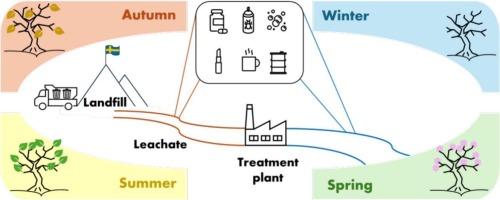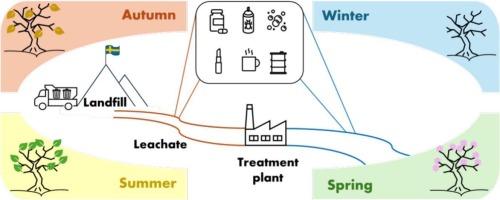对瑞典垃圾填埋场渗滤液中出现的污染物进行定性分析:发生和时空变化的快照
IF 9.7
1区 环境科学与生态学
Q1 ENVIRONMENTAL SCIENCES
引用次数: 0
摘要
垃圾填埋场渗滤液是一种复杂的、尚未得到充分研究的基质,越来越多的人认识到它是一种对环境造成新关注的污染物来源。本研究提供了瑞典垃圾填埋场渗滤液中CECs发生的快照,调查了它们在五个垃圾填埋场的空间分布,以及它们在一个地点一年内的时间格局。据我们所知,这是第一次使用定性非目标和可疑筛选来表征垃圾渗滤液中CECs的时空特征的研究。总共确定了79种CECs,包括工业化学品(ic)、药品和个人护理产品(PPCPs)、全氟和多氟烷基物质(PFASs)、杀虫剂、兴奋剂和甜味剂。在垃圾渗滤液中首次报道了磷酸三异丙酯、1,3-二苯基胍和1,3-二-邻甲基胍等化合物。空间分析显示,CECs在所有地点一致存在,在未经处理和处理的渗滤液中均检测到34种化合物,表明现有处理系统的去除效率有限。在一个填埋场的时间监测显示中等变化,在冬季样品中检测到的CECs数量最多。在所有采样时间点持续检测到集成电路、全氟辛烷磺酸和农药,表明持续浸出,并突出了当前处理方法的局限性。这项研究为瑞典垃圾填埋场渗滤液的化学成分提供了重要的见解,并强调了改进监测和处理策略以减轻与CECs相关的环境风险的必要性。本文章由计算机程序翻译,如有差异,请以英文原文为准。


Qualitative analysis on contaminants of emerging concern in Swedish landfill leachates: a snapshot of occurrence and spatio-temporal variability
Landfill leachate is a complex and understudied matrix increasingly recognized as a source of contaminants of emerging concern (CECs) to the environment. This study provides a snapshot of the occurrence of CECs in Swedish landfill leachates, investigating their spatial distribution across five landfills, and their temporal pattern over a one-year period at one site. To our knowledge, this is the first study using qualitative non-target and suspect screening to characterize the spatio-temporal profile of CECs in landfill leachate. In total, 79 CECs were identified, including industrial chemicals (ICs), pharmaceuticals and personal care products (PPCPs), per- and polyfluoroalkyl substances (PFASs), pesticides, stimulants, and sweetener. Several compounds, such as triisopropyl phosphate, 1,3-diphenylguanidine, and 1,3-di-o-tolylguanidine, were reported for the first time in landfill leachate. Spatial analysis revealed a consistent presence of CECs across all sites, with 34 compounds detected in both untreated and treated leachates, indicating limited removal efficiency of existing treatment systems. Temporal monitoring at one landfill showed moderate variation, with the highest number of CECs detected in the winter samples. Persistent detection of ICs, PFASs, and pesticides at all sampling time points suggests continuous leaching and highlights the limitations of current treatment approaches. This study offers important insights into the chemical composition of Swedish landfill leachate and underscores the need for improved monitoring and treatment strategies to mitigate environmental risks associated with CECs.
求助全文
通过发布文献求助,成功后即可免费获取论文全文。
去求助
来源期刊

Environment International
环境科学-环境科学
CiteScore
21.90
自引率
3.40%
发文量
734
审稿时长
2.8 months
期刊介绍:
Environmental Health publishes manuscripts focusing on critical aspects of environmental and occupational medicine, including studies in toxicology and epidemiology, to illuminate the human health implications of exposure to environmental hazards. The journal adopts an open-access model and practices open peer review.
It caters to scientists and practitioners across all environmental science domains, directly or indirectly impacting human health and well-being. With a commitment to enhancing the prevention of environmentally-related health risks, Environmental Health serves as a public health journal for the community and scientists engaged in matters of public health significance concerning the environment.
 求助内容:
求助内容: 应助结果提醒方式:
应助结果提醒方式:


